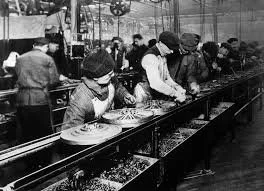Life on the Assembly Line
Comics do funny things with time. Certainly, we saw this in the last chapter, where Doctor Manhattan's four-dimensional vision turns out to be a metaphor for the reader's interaction with a printed comic book, There, the time bending involved the layout of each page and the collection of the pages in one easily-thumbed pamphlet. But serialized comics (as opposed to original graphic novels (OGNs)) have their own, very specific relationship with real time, due to their status as periodicals. As I mentioned in the introduction, such comics might best be conceived of as a flow, beginning at a point of origin and always flowing in one direction (the future), even though the reader's experience of a comics series can recapitulate the possible experience of an individual comics: the reader can hop around freely from one point on the line to another, doubling back to the past and skipping ahead to the future at will. Writers can insert retroactive continuities in their current comics, thereby all but demanding a re-reading of past comics in a different light. There are pleasures to be found, both in reading in sequence and in re-reading based on new (retroactive) information. For longtime readers of the Big Two, this is Comics 101.
That is only one side of the story, however. Sequence, seriality, and mass production are the mainstays of modern and postmodern life, but they are also fraught. Hence the first half of the twentieth century's multiple cautionary tales about industrialized flows, as both disturbing dystopias (Brave New World, Kurt Vonnegut, Jr's Player Piano) and delightful farces: Charlie Chaplin failing to master the assembly line in Modern Times (1936), and Lucy and Ethel's hapless and hilarious attempts to adapt themselves to the inhuman pace of a chocolate factory assembly line in a 1952 episode of I Love Lucy called "Job Switching." When Lucy and Ethel prove unable to maintain the conveyer belt's breakneck pace, not only do they throw chocolates into their mouths and down their blouses, they pick up chocolates that are moving past them and put them further back on the belt.
Those were the days
Life may not be like Forrest Gump's proverbial box of chocolates, but comics continuity works like the chocolates' conveyer belt. Like the people who buy and eat the finished products once they have been wrapped and shipped, casual readers of superhero comics are unconcerned with the process that led to the stories that they consume. Hardcore fans, however, are much more bothered by the sequence of the comics that they buy, while editors, like poor Lucy and Ethel, end up frantically moving their wares up and down the line. They try to put everything back in order, even when any possibility of coherence is vanishingly small.
Where readers find themselves metaphorically encoded into comics as watchers, editors enter their fictional worlds as meddlers, bureaucrats, and outright villains. When continuity itself is at stake, the threat faced by the heroes usually ends up encoded as some variation of the editorial function: wiping everything out and restoring a blank slate, reaching into the world as a giant hand ready to (re)start everything, deciding that a character's marriage or revelation of their secret identity must be undone, demanding a return to simpler days, insisting on a clear and orderly taxonomy of all multiversal variations, erasing alternative timelines and variant characters, and even breaking reality through brute force. With great editorial power comes great storyworld mutability.
Though meddler figures (the umbrella term I propose for the entire category) confront the ethical questions surrounding intervention from a vantage point that could not be farther apart from that of the Watchers, they end up in some of the same moral gray areas as their noninterventionist counterparts. As part of the same system of corporate superhero comics, watchers and meddlers are required to reinforce, if not the status quo of continuity itself, then the ethical status quo in which most of these comics are suspended. Vigilantism is a net positive within the framework of crime, villainy, and disaster, but willful intervention into larger structures is more complicated, whether those structures be the sociopolitical system that sets the laws and classifies certain acts as crime, or the possibly unjust or unstable cosmos that provides a backdrop for crime and heroism. The impulses behind such interventions may be noble or craven, and the results might be what the actual editors require, but the meddler figures themselves are almost always in the wrong.
Like Marvel's "What If?" scenarios, which are usually so bleak as to confirm that mainstream continuity is on the right path, superhero interventions into law, government and broad social problems must almost always lead to terrible results; if they are within mainstream continuity, they have to be reversed, and if they are not, they lay the foundation for yet another dystopian parallel world. Interventions into the nature of the cosmos (crises, reboots, etc.) must be defined as wrong, but their results are allowed to remain in place (at least until the next crisis). Meddlers in law and politics are reminders of the impossibility of change, while meddlers in continuity affirm change's necessity. Each case demands that the readers assent to the world order presented to them, no matter how flawed. Yes, our laws and criminal justice system aren't perfect, but the alternatives are totalitarianism, fascism, or chaos. Yes, the new continuity is the after-effect of villainy (and has probably erased some of our favorite characters or storylines), but the in-universe alternative is annihilation, and the editorial alternative is stagnation, falling sales, and the oblivion that could be brought on by the collapse of a given company or even the entire industry.
Next: The Real World Problem
